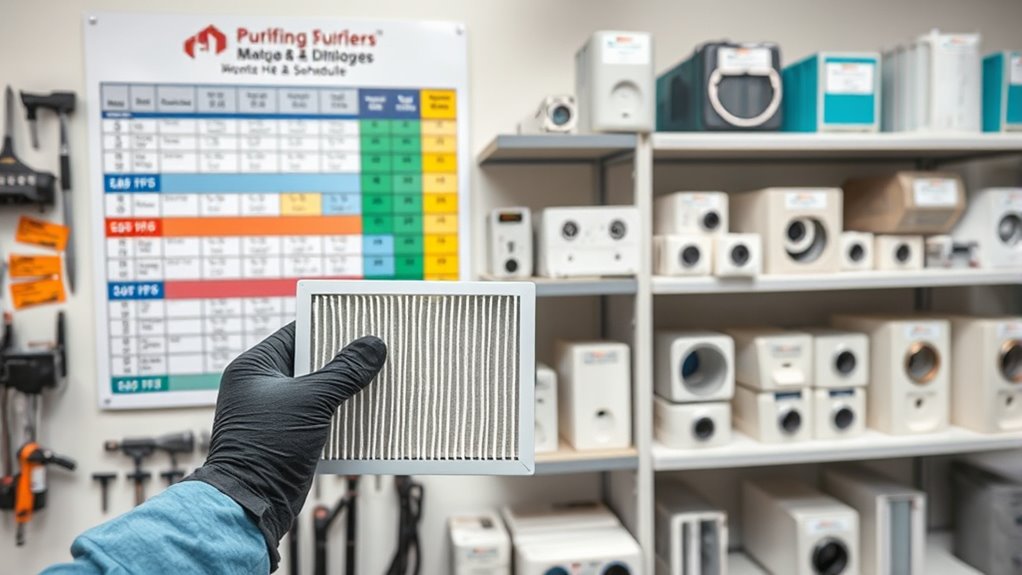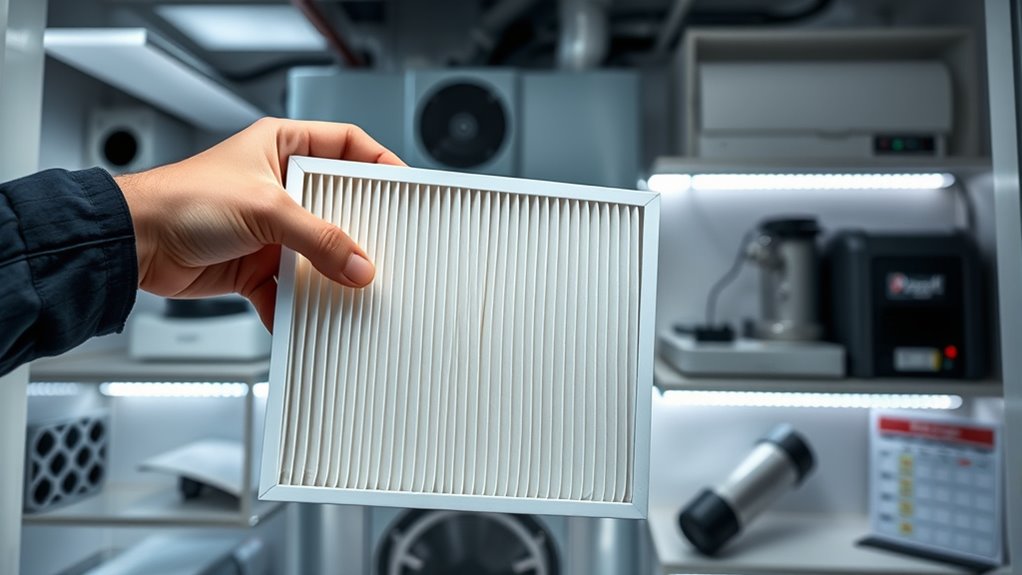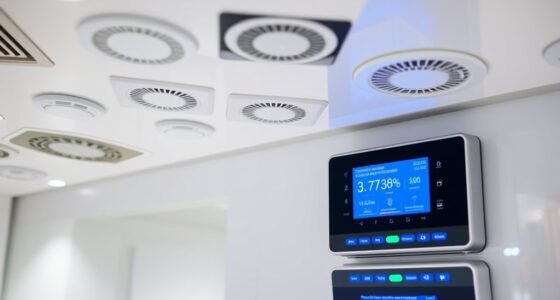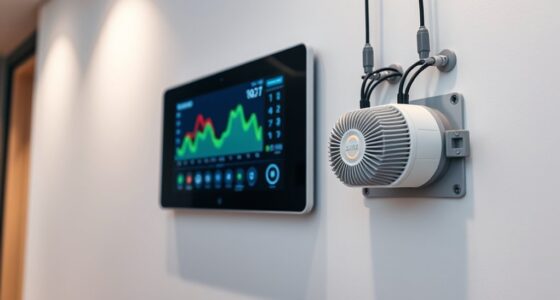To keep your HVAC filters and purifiers working efficiently, check filters every 1 to 3 months and replace them sooner if they look dirty. Most purifiers need filter changes or cleaning every 6 to 12 months, depending on the type. Regular maintenance, like inspecting for damage or reduced airflow, helps prevent system failures and ensures good indoor air quality. Stay tuned to learn detailed schedules and tips to make your system last longer.
Key Takeaways
- Check HVAC filters every 1 to 3 months, especially during peak seasons, and replace if dirty or clogged.
- Replace purifier filters every 6 to 12 months, or sooner if performance declines.
- Follow manufacturer guidelines for specific maintenance intervals and filter types.
- Use calendar reminders to schedule regular filter replacements and purifier servicing.
- Inspect for signs of wear or reduced airflow, and perform maintenance to ensure optimal indoor air quality.

Regular maintenance of your HVAC filters and purifiers is essential to guarantee clean indoor air and ideal system performance. When it comes to filter replacement, sticking to a consistent schedule ensures that your system operates efficiently and that your indoor environment remains healthy. Typically, you should check your filters every one to three months, especially during peak usage seasons like winter and summer. If you notice a significant buildup of dust or debris, it’s a clear sign that you need to replace the filter sooner rather than later. Using high-quality filters and replacing them regularly prevents dirt and allergens from circulating, which is crucial for allergy sufferers or those with respiratory issues.
Purifier servicing is equally important and should be part of your routine maintenance. Depending on the type of purifier you have—whether it’s an air purifier with HEPA filters or an advanced model with activated carbon—the servicing frequency can vary. Many manufacturers recommend a thorough cleaning or replacement of filters every six to twelve months. Regular purifier servicing not only extends the lifespan of your device but also maintains its efficiency in removing pollutants, odors, and airborne pathogens. When servicing your purifier, check for signs of wear or damage, such as a decrease in airflow or unusual noises, which could indicate the need for component replacement or repair. Additionally, maintaining system air quality helps prevent buildup that can impair performance.
Integrating filter replacement and purifier servicing into your maintenance routine is straightforward. Mark your calendar or set reminders to perform these tasks, especially as seasons change or during periods of increased indoor activity. Remember, neglecting timely filter replacements can cause your HVAC system to work harder, increasing energy consumption and risking system breakdowns. Similarly, unserviced purifiers can become less effective, allowing pollutants to accumulate and compromise indoor air quality. It’s worth investing a little time and effort to keep these components in top shape because doing so saves you money on energy costs and prolongs your equipment’s lifespan.
If you’re unsure about the right schedule for your specific system, consult your HVAC or purifier manufacturer’s guidelines. Some systems come with indicator lights that signal when filter replacement or servicing is needed, making maintenance even easier. Ultimately, staying on top of filter replacement and purifier servicing is a simple yet essential step to ensure your indoor air remains fresh and your HVAC system functions at its best. Regular upkeep not only enhances comfort but also promotes a healthier living environment for you and your family.
Frequently Asked Questions
How Do I Identify When My HVAC Filter Needs Replacing?
You’ll know it’s time for filter replacement when you notice reduced airflow or increased dust and allergies. A dirty filter can compromise air quality and strain your HVAC system. Check the filter every 1-3 months, especially during heavy use, and replace it if it looks clogged or discolored. Keeping up with filter replacement guarantees better air quality and energy efficiency, helping your system run smoothly.
Are There Eco-Friendly Options for HVAC Filters and Purifiers?
Like a green knight defending your castle, eco-friendly filters do exist. You can opt for biodegradable filters made from sustainable materials, which break down naturally and reduce landfill waste. These eco-friendly options often use recycled or organic materials, making them better for the environment. By choosing biodegradable filters, you protect your air quality while also championing sustainability, turning your home into a true fortress of eco-conscious living.
Can Regular Maintenance Extend the Lifespan of My HVAC Unit?
Yes, regular maintenance can substantially extend your HVAC unit’s lifespan. When you keep filters clean and replace them as needed, your system runs efficiently, improving air quality and reducing strain on components. This proactive approach not only enhances air quality but also leads to cost savings by preventing costly repairs and lowering energy bills. Consistent upkeep ensures your system operates smoothly longer, saving you money and maintaining a healthier indoor environment.
What Are the Signs of a Malfunctioning Air Purifier?
You’ll notice your air purifier isn’t working properly if airflow reduction occurs or if you detect unusual odors. Reduced airflow means it struggles to circulate air effectively, while odd smells suggest it’s not filtering contaminants well. Additionally, if your purifier makes strange noises or the indicator lights malfunction, these are signs it might be malfunctioning. Address these issues promptly to make certain your air stays clean and healthy.
How Does Filter Type Affect Maintenance Frequency?
The filter type directly affects your maintenance frequency because different filters have varying lifespans. HEPA filters, for instance, need replacing every 6 to 12 months, while activated carbon filters may last around 3 to 6 months. Knowing your filter’s lifespan helps you set proper maintenance intervals, ensuring your air purifier performs efficiently and maintains good air quality without unnecessary replacements. Regular checks keep your system running smoothly.
Conclusion
By sticking to your maintenance schedule, you’re tending to your indoor air like a gardener nurturing delicate blooms. Regularly changing filters and cleaning purifiers keeps your home’s air fresh and vibrant, preventing buildup from turning into a storm. Think of it as a gentle dance—each step ensures your system flows smoothly, protecting your health and comfort. When you prioritize these small acts, you’re cultivating a sanctuary where clean air blossoms, thriving under your attentive care.









